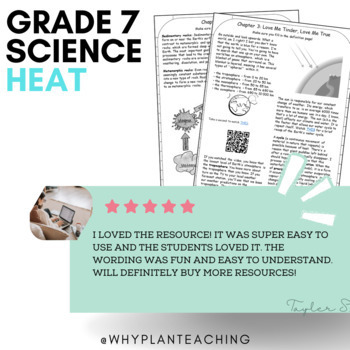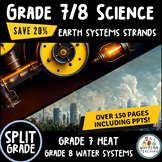2022 Curriculum- Grade 7 Ontario Science Workbook - Heat In The Environment
- Zip
- Internet Activities
- Easel Assessment
What educators are saying
Also included in
- The ultimate grade 7 science resources are tailored to the Ontario Science Curriculum of 2022. These four units of (pure substances and mixtures, interactions in the environment, heat, forms and functions) are for educators seeking comprehensive and engaging content. I've recently updated and reformPrice $15.30Original Price $19.96Save $4.66
- Students will learn a variety of specific and global expectations in grade 7 and 8 Ontario Science Curriculum. Great news, all of my grades 7 and 8 Ontario science chapters have been bundled together, creating the ultimate Intermediate Science Bundle. I'll get straight to the point. Many students doPrice $30.60Original Price $41.72Save $11.12
- ✬Enjoy all of our Ontario Grade 8 and Grade 7 Science Units in this bundle!(This bundle includes both French and English science units)Before I describe this resource, I'd like to share my innovation with you; QR codes! This unit has QR codes and embedded links for your/your students' convenience! TPrice $55.62Original Price $81.77Save $26.15
- Introducing my science unit bundle for Grades 7 and 8, based on the Ontario Science Curriculum and focused on Earth and Space Systems. This bundle combines two related units that align with the curriculum to provide students with a comprehensive understanding of the complex systems that govern our pPrice $4.75Original Price $6.99Save $2.24
Description
This resource aligns with the global and specific expectations outlined in Ontario's grade 7 science curriculum (Understanding Matter and Energy - Heat). In this science resource, students in grade 7 will delve into heat by evaluating the pros and cons of different heating technologies, exploring how heat impacts matter, and grasping that heat is a form of energy composed of particles.
As part of this resource, students can also analyze real-world scenarios and apply their understanding of heat to solve problems. For example, students might consider the most energy-efficient way to heat a home or the impact of various heating technologies on the environment. Through these activities, students will develop critical thinking skills and learn to consider the cost and benefits of different approaches to heating.
Overall, this resource is designed to provide students with a thorough and engaging learning experience covering all the key heat-related concepts. By the end of this resource, students will have a strong foundation in the science of heat and be well-prepared to move on to more advanced topics in science and beyond.
I'll get straight to the point. Many students don't enjoy reading textbooks because the content is often very dry and bland. Most books get straight to the point and lose student interest. Upon purchasing this teaching resource, you'll notice that this packet is written differently. It's informal, loaded with jokes, and tries to teach students on a personal level. Moreover, it entices them to try to perform their own inquiry-based independent science experiments at home. I wanted to write it as if I were conversing with your students. It's a short unit(compared to textbook units), but it is filled with embedded links, QR codes, an online version of all chapter questions, unit tests, and independent research. It has everything you need to cover the specific and global expectations of the Ontario science curriculum.
I would consider this resource "low-prep" as there is nothing required of you but to print it. However, there may be some science experiments that require some setup. I've included some chapter quizzes/assignments in PDF and Google Forms. Use these tasks as consolidation assignments or discussion topics in your classroom! The content of this packet is relevant and accurate. It will not impede their understanding!
July 2022: Good news! I just became a certified easel creator! I decided to start putting them in some of my resources. This resource currently has the following:
- Chapter 1 Easel assessment
- Chapter 2 Easel assessment
- Chapter 3 Easel assessment
- Chapter 4 Easel assessment
- Chapter 5 Easel assessment
Easel allows teachers to modify purchased resources, including movable pieces, apply pen activities, highlight, link sharing, and add/remove questions. Easel's goal is to foster differentiation in the classroom.
✬This resource has 5 chapters:
Chapter 1: Who Doesn't Love the Energizer Bunny?
Chapter 2: We All Scream For Ice Cream
Chapter 3: Love Me Tinder, Love Me True
Chapter 4: Rock Solid
Chapter 5: We Need To Do Something, Right?
✬It also has the following:
- Vocabulary sheets
- Printable student journals
- Readings and worksheets
- Answer Keys
- Study questions
- Google Forms quizzes, embedded links, and QR codes (to online videos).
- Interactive navigation (for your convenience)
- A PowerPoint presentation for teaching
- Unit test
- 2022 curriculum change add-on (renewable vs. non-renewable mini research)
- 2023 Changes - New font (LEXEND) and change of look
- Extended activities, experiments, and assignments
- Interactive resource navigation
✬Need any other scientific resources?
- Grade 7 Pure Substances and Mixtures
- Grade 7 Forms and Functions
- Grade 7 Interactions in The Environment
Blog ✎ Facebook ✎ Instagram ✎ Pinterest
Have trouble printing? Click here.










